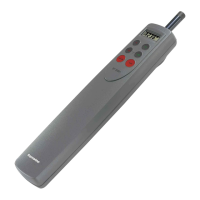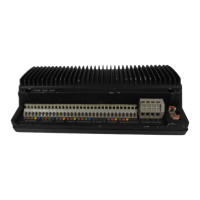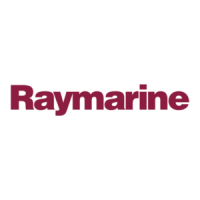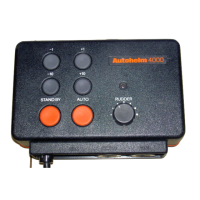Do you have a question about the Raymarine Autohelm ST6000 and is the answer not in the manual?
Engages automatic steering and maintains current heading.
Alters course to port or starboard in 1 and 10-degree increments.
Disengages the autopilot for manual steering.
Selects the built-in track control for steering under navigation system supervision.
Adjusts course keeping response level and rudder gain.
Controls the display illumination level.
Shows primary information like heading or standby status.
Displays the current compass heading.
Shows the current rudder angle.
Displays the locked course heading.
Indicates deviation from the desired track.
Shows the bearing to the target waypoint.
Displays the distance to the target waypoint.
Shows the current waypoint number.
Activates an alarm for monitoring purposes.
Built-in function to turn the vessel through 100 degrees.
Supervises autopilot by apparent wind direction.
Shows apparent wind angle and tack sense on display.
Alerts if apparent wind angle changes significantly.
Sets one of three response levels for course keeping.
Guidance for optimal use of track control.
How the system advances to the next waypoint.
Automatic correction for vessel trim changes.
Adjusts rudder gain for sail vessel steering performance.
Adjusts rudder gain for powercraft steering performance.
Troubleshooting tips for poor steering.
Houses the microprocessor, control circuitry, and power amplifier.
Designed for above or below deck mounting, accepts navigation data.
Provides accurate readings with pitch and roll movements.
Provides precise rudder position to the course computer.
Connects to solenoids on hydraulic power packs.
Details various drive units available for the system.
Couples to steering mechanism via chain drive.
Couples directly to the rudder stock at the tiller arm.
Actuator for power assisted stern drive steering systems.
Hydraulic drive units dependent on vessel size and displacement.
Provides autopilot drive system for high steering loads.
Mounting position and instructions for the course computer.
Mounting position and instructions for the control unit.
Positioning and mounting precautions for the fluxgate compass.
Mounting and alignment of the rudder reference unit.
Details installation procedures for various drive systems.
Installation instructions for the rotary drive unit.
Installation instructions for the linear drive unit.
Installation instructions for the stern drive actuator.
General guidelines and installation for hydraulic drive units.
Wiring and power supply connection details.
Details for connecting signal cables between components.
Connection details for SeaTalk units.
Connecting NMEA data input to the control unit.
Requirements for the vessel's central DC power supply.
Specific installation for the stern drive actuator.
Procedure for switching on the system and initial checks.
Checks the rudder angle transducer's sensing direction.
Verifies system integrity during manual steering.
Ensures zero rudder angle display when rudder is amidships.
Checks the direction of rudder movement with Auto engage.
Sets the deadband for stable rudder positioning.
Verifies system integrity during autopilot steering.
Tests stern drive actuator auto release function.
Sets the maximum rudder angle the autopilot can move.
Lists suggested calibration settings for different vessel types.
Procedure for entering and exiting calibration mode.
How to adjust calibration parameters like limits and gain.
Adjusts the LCD screen contrast for optimal viewing.
Table to record fine-tuned calibration settings.
Reference tables for rudder and rate gain values.
Corrects fluxgate compass for magnetic deviation.
Basic steps for initial sea trials in calm conditions.
Explains the three response levels for course keeping.
Automatic correction for trim changes during operation.
Adjusts rudder gain for displacement hull performance.
Adjusts rudder gain for high-speed planing hull performance.
Enables manual steering override for stern drive systems.
Adjusts rate gain for improved course keeping accuracy.
Procedure to align the compass without automatic deviation correction.
Confirms navigation data reception for track control.
Guidance for optimizing track control performance.
Engages automatic steering and maintains current heading.
Alters course to port or starboard in 1 and 10-degree increments.
Disengages the autopilot for manual steering.
Selects the built-in track control for steering under navigation system supervision.
Adjusts course keeping response level and rudder gain.
Controls the display illumination level.
Shows primary information like heading or standby status.
Displays the current compass heading.
Shows the current rudder angle.
Displays the locked course heading.
Indicates deviation from the desired track.
Shows the bearing to the target waypoint.
Displays the distance to the target waypoint.
Shows the current waypoint number.
Activates an alarm for monitoring purposes.
Built-in function to turn the vessel through 100 degrees.
Supervises autopilot by apparent wind direction.
Shows apparent wind angle and tack sense on display.
Alerts if apparent wind angle changes significantly.
Sets one of three response levels for course keeping.
Guidance for optimal use of track control.
How the system advances to the next waypoint.
Automatic correction for vessel trim changes.
Adjusts rudder gain for sail vessel steering performance.
Adjusts rudder gain for powercraft steering performance.
Troubleshooting tips for poor steering.
Houses the microprocessor, control circuitry, and power amplifier.
Designed for above or below deck mounting, accepts navigation data.
Provides accurate readings with pitch and roll movements.
Provides precise rudder position to the course computer.
Connects to solenoids on hydraulic power packs.
Details various drive units available for the system.
Couples to steering mechanism via chain drive.
Couples directly to the rudder stock at the tiller arm.
Actuator for power assisted stern drive steering systems.
Hydraulic drive units dependent on vessel size and displacement.
Provides autopilot drive system for high steering loads.
Mounting position and instructions for the course computer.
Mounting position and instructions for the control unit.
Positioning and mounting precautions for the fluxgate compass.
Mounting and alignment of the rudder reference unit.
Details installation procedures for various drive systems.
Installation instructions for the rotary drive unit.
Installation instructions for the linear drive unit.
Installation instructions for the stern drive actuator.
General guidelines and installation for hydraulic drive units.
Wiring and power supply connection details.
Details for connecting signal cables between components.
Connection details for SeaTalk units.
Connecting NMEA data input to the control unit.
Requirements for the vessel's central DC power supply.
Specific installation for the stern drive actuator.
Procedure for switching on the system and initial checks.
Checks the rudder angle transducer's sensing direction.
Verifies system integrity during manual steering.
Ensures zero rudder angle display when rudder is amidships.
Checks the direction of rudder movement with Auto engage.
Sets the deadband for stable rudder positioning.
Verifies system integrity during autopilot steering.
Tests stern drive actuator auto release function.
Sets the maximum rudder angle the autopilot can move.
Lists suggested calibration settings for different vessel types.
Procedure for entering and exiting calibration mode.
How to adjust calibration parameters like limits and gain.
Adjusts the LCD screen contrast for optimal viewing.
Table to record fine-tuned calibration settings.
Reference tables for rudder and rate gain values.
Corrects fluxgate compass for magnetic deviation.
Basic steps for initial sea trials in calm conditions.
Explains the three response levels for course keeping.
Automatic correction for trim changes during operation.
Adjusts rudder gain for displacement hull performance.
Adjusts rudder gain for high-speed planing hull performance.
Enables manual steering override for stern drive systems.
Adjusts rate gain for improved course keeping accuracy.
Procedure to align the compass without automatic deviation correction.
Confirms navigation data reception for track control.
Guidance for optimizing track control performance.
| Type | Autopilot System |
|---|---|
| Model | ST6000 |
| Display | LCD |
| Drive Type | Linear or Rotary |
| Drive Unit | Separate |
| Power Supply | 12V DC |
| Data Interface | SeaTalk |
| NMEA Interface | NMEA 0183 |
| Compass | Fluxgate |
| Rudder Feedback | Yes |
| Compatibility | Raymarine SeaTalk |











